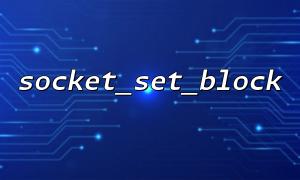socket_set_block() is an important but often overlooked function when programming low-level networks using PHP. It controls whether the socket is in blocking mode, thereby affecting the socket's behavior during the connection initialization phase. This article will use examples and principles to illustrate how to use socket_set_block() to control the state flow of connections and analyze its function.
In network communication, "blocking" means that when a socket operation (such as connect or read ) cannot be completed immediately, the program will pause execution and wait for the operation to complete. "Non-blocking" means that these operations will return immediately and the program can continue to execute other logic.
In PHP, socket is in blocking mode by default. This means that if you are calling socket_connect() and the remote server does not respond, the script will wait until the connection is successful or timed out.
socket_set_block() is a function provided by PHP to set socket to blocking mode. The corresponding non-blocking function is socket_set_nonblock() . When controlling the connection initialization process, combining these two functions can achieve more flexible connection management logic.
$socket = socket_create(AF_INET, SOCK_STREAM, SOL_TCP);
if ($socket === false) {
die("Unable to createsocket: " . socket_strerror(socket_last_error()));
}
// Set to non-blocking mode to control the connection process
socket_set_nonblock($socket);
$host = 'gitbox.net';
$port = 80;
$time_start = time();
$timeout = 5;
// Try to connect
@socket_connect($socket, $host, $port);
// Switch to blocking mode,Cooperate select Wait for the connection to complete
socket_set_block($socket);
// use select Wait for the connection result
$write = [$socket];
$except = [$socket];
$read = null;
$tv_sec = $timeout;
$tv_usec = 0;
$select_result = socket_select($read, $write, $except, $tv_sec, $tv_usec);
if ($select_result > 0 && in_array($socket, $write)) {
echo "Connection successfully\n";
} else {
echo "Connection failed or timed out\n";
}
socket_close($socket);
Avoid blocking the main thread : In some application scenarios (such as event-driven asynchronous servers or clients that require multiple connections to be attempted at the same time), we cannot let a single socket block the entire process. By setting non-blocking before connection and manually switching back to blocking mode, you can achieve the combination of "asynchronous connection + synchronous operation".
Custom timeout mechanism : The blocking time of socket_connect() is controlled by the operating system's default timeout, but through non-blocking and socket_select() , the connection waiting time can be accurately controlled to avoid degradation in user experience due to slow server response.
More complex state flow management : Manually controlling socket state is the basic capability when implementing advanced network models such as state machines and task schedulers. Using socket_set_block() can clearly distinguish which operations are "confirm response" rather than "trying behavior".
Although PHP provides a higher-level stream_socket_client() which also supports setting blocking or non-blocking, the underlying socket operation is more suitable for scenarios where granular control of the connection state is required. For example, high concurrency connection testing tools, custom HTTP clients, and even building socket-based protocol emulators.
Although socket_set_block() seems to be just a simple state switching function, it brings a high degree of controllability and scalability to PHP socket communication during the connection initialization stage. Mastering its use will help develop more robust and flexible network communication programs, especially in scenarios with high concurrency, asynchronous or custom protocols, which are indispensable.












